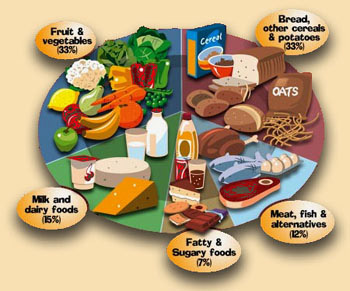Healthy Food For Children Definiton
Source : Google.com.pk
By teaching your children healthy eating habits, and modeling these behaviors in yourself, you can help your children maintain a healthy weight and normal growth. Also, the eating habits your children pick up when they are young will help them maintain a healthy lifestyle when they are adults.
Your child's health care provider can evaluate your child's weight and growth and let you know if your child needs to lose or gain weight or if any dietary changes need to be made.
Some of the most important aspects of healthy eating are portion control and cutting down on how much fat your child eats. Simple ways to reduce fat intake in your child's diet and promote a healthy weight include serving:
low-fat or nonfat dairy products
poultry without skin
lean cuts of meats
whole grain breads and cereals
Also, reduce the amount of sugar sweetened drinks and salt in your child's diet.
If you are unsure about how to select and prepare a variety of foods for your family, consult a registered dietitian for nutrition counseling.
It is important that you do not place your overweight child(ren) on a restrictive diet. Children should never be placed on a restrictive diet to lose weight unless a doctor supervises one for medical reasons.
Other approaches parents can take to develop healthy eating habits in their children include:
Guide your family's choices rather than dictate foods. Make a wide variety of healthful foods available in the house. This practice will help your children learn how to make healthy food choices. Leave the unhealthy choices like soda and juice at the grocery store. Serve water with meals.
Encourage your children to eat slowly. A child can detect hunger and fullness better when they eat slowly. Before offering a second helping or serving, ask your child to wait a few minutes to see if they are truly still hungry. This will give the brain time to register fullness.
Eat meals together as a family as often as possible. Try to make mealtimes pleasant with conversation and sharing, not a time for scolding or arguing. If mealtimes are unpleasant, children may try to eat faster to leave the table as soon as possible. They then may learn to associate eating with stress.
Involve your children in food shopping and preparing meals. These activities will give you hints about your children's food preferences, an opportunity to teach your children about nutrition, and provide your kids with a feeling of accomplishment. In addition, children may be more willing to eat or try foods that they help prepare.
Plan for snacks. Continuous snacking may lead to overeating, but snacks that are planned at specific times during the day can be part of a nutritious diet, without spoiling a child's appetite at meal times. You should make snacks as nutritious as possible, without depriving your children of occasional chips or cookies, especially at parties or other social events.
Discourage eating meals or snacks while watching TV. Try to eat only in designated areas of your home, such as the dining room or kitchen. Eating in front of the TV may make it difficult to pay attention to feelings of fullness, and may lead to overeating.
Encourage your children to drink more water. Over consumption of sweetened drinks and sodas has been linked to increased rates of obesity in children.
Try not to use food to punish or reward your children. Withholding food as a punishment may lead children to worry that they will not get enough food. For example, sending children to bed without any dinner may cause them to worry that they will go hungry. As a result, children may try to eat whenever they get a chance. Similarly, when foods, such as sweets, are used as a reward, children may assume that these foods are better or more valuable than other foods. For example, telling children that they will get dessert if they eat all of their vegetables sends the wrong message about vegetables.
Make sure your children's meals outside the home are balanced. Find out more about their school lunch program, or pack their lunch to include a variety of foods. Also, select healthier items when dining at restaurants.
Pay attention to portion size and ingredients.
A healthy meal plan has enough nutrients for children to grow well and be healthy. The amount of nutrients your child needs depends on his age and his physical activity level. A healthy meal plan limits unhealthy foods that are high in fat and sugar. This can help your child stay at a healthy weight and prevent certain health problems later in life. These health problems include diabetes, high blood pressure, and high cholesterol.
Foods high in fat and sugar do not have the nutrients he needs to be healthy. These foods include snack foods (potato chips, candy, and other sweets), juice, fruit drinks, and soda. If he snacks on these foods throughout the day, he may eat fewer healthy foods during meals. Added snacks and drinks between meals may cause your child to gain too much weight. Your child may also develop anemia (low levels of iron in his blood). Anemia can affect your child's growth and ability to learn.
Foods that cause your child to choke include hot dogs, raw vegetables, hard candy, and nuts. These foods may cause children under 5 years old to choke. Young children who do not have all their teeth cannot chew and swallow these foods easily.
Children between 1 and 2 years are still developing eating skills. Food may end up on the floor or on your child instead of in his mouth. Be patient and let your child learn how to use a spoon to feed himself. Avoid giving your child a fork or knife until he is able to use it without hurting himself.
Give your child whole milk until he is 2 years old. His body needs the extra fat in whole milk to help him grow. After he turns 2 years old, he can drink skim or low-fat milk (such as 1 or 2% milk).
Feed your child a variety of healthy foods from all of the food groups. You do not need to count calories, make him stop eating, or tell him to eat more. Most children know how much food their body needs at one time. Let your child decide how much of the food he wants to eat. Give him small portions and then let him have another serving if he asks for one.
Do not force your child to eat new foods if he does not want to. Offer the food again after a few days, and let your child decide if he wants to eat it. Children need to see a new food as many as 8 or 10 times before they are willing to eat it.
Small children can be very picky. Your child may like a certain food on one day and then decide he does not like it the next day. He may eat only 1 or 2 foods for a whole week or longer. Your child may not like mixed foods. These eating habits are normal. Offer 2 or 3 different foods at each meal.










Useful information you provided.
ReplyDeleteIt helps as Healthy food recipe for kids and adults.
http://www.horlicks.in